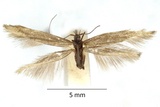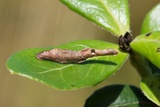Coleophora vacciniella Herrich-Schäffer, 1861 Species
Last modified: Dec. 20, 2024, 3:30 p.m.
First observation in Belgium of this very rare species was in 1990 in LG.
Details
- Classification
- Family: Coleophoridae > Genus: Coleophora > Species: Coleophora vacciniella
- Vernacular names
- Grote bosbeskokermot (NL)
- First mention in Belgium
- Wullaert S. 2013. Coleophora vacciniella (Lepidoptera: Coleophoridae), new to the Belgian fauna. — Phegea 41(2): 42–44. On page 42 (as Coleophora vacciniella Herrich-Schäffer, 1861). view page
- Status
-
Native
Distribution
Egg
The eggs are black.
No pictures yet!
Caterpillar
The caterpillar is reddish brown with a lighter brown to dark brown head.
No pictures yet!
Case
The case is brown with a length between 8–15 mm and has a mouth angle of 40 to 55°.
See also bladmineerders.be.
Bionomics
The eggs are laid on the underside of the leaf. The larvae hibernate in the case and pupate shortly after the winter.
No pictures yet!
Flight periods
They are on the wing from late April till mid-June.
Observed on
- Host plant (species):
- Vaccinium myrtillus, Vaccinium uliginosum, Vaccinium vitis-idaea and Andromeda polifolia
- Host plant (genera):
- Vaccinium
The caterpillars feed on Ericaceae like Vaccinium vitis-idaea, Vaccinium myrtillus and Vaccinium uliginosum. Sometimes also on Andromeda polifolia, but this plant is very rare and local in Belgium.
No pictures yet!




